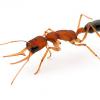- Formiculture.com
- Forums
- Gallery
- Members
- Member Map
- Chat

Can pls get an ID
Started By
WILLj
, Jan 18 2020 1:54 AM
17 replies to this topic
#1
 Offline
-
Posted January 18 2020 - 1:54 AM
Offline
-
Posted January 18 2020 - 1:54 AM
So I recently caught six queens in Sydney, Australia. The queens I caught may indeed be some species of pheidole, but I am unsure as although they look very similar, they have some small colour differences. The bodies are a dark black and the heads are a reddish colour. I found them running around on a tennis court last night(17th January 2020)
Link to photo:https://albumizr.com/a/
Sorry for the not-that-good photo
Link to photo:https://albumizr.com/a/
Sorry for the not-that-good photo
#2
 Offline
-
Posted January 18 2020 - 1:58 AM
Offline
-
Posted January 18 2020 - 1:58 AM
#3
 Offline
-
Posted January 18 2020 - 2:44 AM
Offline
-
Posted January 18 2020 - 2:44 AM
Can you provide pictures from several angles please?
#4
 Offline
-
Posted January 18 2020 - 6:05 AM
Offline
-
Posted January 18 2020 - 6:05 AM
Perhaps an overhead view and profile view? I think I see 2 petioles but i'm not sure.
#5
 Offline
-
Posted January 18 2020 - 7:47 AM
Offline
-
Posted January 18 2020 - 7:47 AM
Length?
Spoiler
#6
 Offline
-
Posted January 18 2020 - 7:49 AM
Offline
-
Posted January 18 2020 - 7:49 AM
It's a Myrmicine. Either Pheidole or Carebara. Probably the former.
Hi there! I went on a 6 month or so hiatus, in part due, and in part cause of the death of my colonies.
However, I went back to the Sierras, and restarted my collection, which is now as follows:
Aphaenogaster uinta, Camponotus vicinus, Camponotus modoc, Formica cf. aserva, Formica cf. micropthalma, Formica cf. manni, Formica subpolita, Formica cf. subaenescens, Lasius americanus, Manica invidia, Pogonomyrmex salinus, Pogonomyrmex sp. 1, Solenopsis validiuscula, & Solenopsis sp. 3 (new Sierra variant).
#7
 Offline
-
Posted January 18 2020 - 8:35 AM
Offline
-
Posted January 18 2020 - 8:35 AM
Definitely Pheidole sp, maybe megacephala.
Edited by Manitobant, January 18 2020 - 8:41 AM.
My journals:
Polyergus Mexicanus: https://www.formicul...gs/#entry175528
Lasius minutus: https://www.formicul...cs/#entry174811
Lasius latipes: https://www.formicul...gs/#entry206449
General acanthomyops journal: https://www.formicul...yops-with-eggs/
Polyergus Mexicanus: https://www.formicul...gs/#entry175528
Lasius minutus: https://www.formicul...cs/#entry174811
Lasius latipes: https://www.formicul...gs/#entry206449
General acanthomyops journal: https://www.formicul...yops-with-eggs/
#8
 Offline
-
Posted January 18 2020 - 8:53 AM
Offline
-
Posted January 18 2020 - 8:53 AM
Probably not. I don't think they are that prevalent there.
Hi there! I went on a 6 month or so hiatus, in part due, and in part cause of the death of my colonies.
However, I went back to the Sierras, and restarted my collection, which is now as follows:
Aphaenogaster uinta, Camponotus vicinus, Camponotus modoc, Formica cf. aserva, Formica cf. micropthalma, Formica cf. manni, Formica subpolita, Formica cf. subaenescens, Lasius americanus, Manica invidia, Pogonomyrmex salinus, Pogonomyrmex sp. 1, Solenopsis validiuscula, & Solenopsis sp. 3 (new Sierra variant).
#9
 Offline
-
Posted January 18 2020 - 10:16 AM
Offline
-
Posted January 18 2020 - 10:16 AM
Pheidole sp. We can't give you a species ID, there are too many identical and undescribed species in Aus.
#10
 Offline
-
Posted January 18 2020 - 10:18 AM
Offline
-
Posted January 18 2020 - 10:18 AM
Meranopolus was my first guess. It doesn’t look “stocky” enough for a Pheidole.
Edit: Er, actually I think Pheidole is a strong possibility. A measurement is needed to really tell anything about her.
Edit: Er, actually I think Pheidole is a strong possibility. A measurement is needed to really tell anything about her.
Edited by Martialis, January 18 2020 - 10:21 AM.
Spoiler
#11
 Offline
-
Posted January 18 2020 - 10:24 AM
Offline
-
Posted January 18 2020 - 10:24 AM
Pheidole is near garenteed.
#12
 Offline
-
Posted January 18 2020 - 10:39 AM
Offline
-
Posted January 18 2020 - 10:39 AM
Megacephala has a lot of records from sydney and comes in many different color forms. There is also a reddish tint on the thorax which leads me to believe its megacephala. Even if it isn't, its 100% a pheidole queen.
Edited by Manitobant, January 18 2020 - 10:40 AM.
My journals:
Polyergus Mexicanus: https://www.formicul...gs/#entry175528
Lasius minutus: https://www.formicul...cs/#entry174811
Lasius latipes: https://www.formicul...gs/#entry206449
General acanthomyops journal: https://www.formicul...yops-with-eggs/
Polyergus Mexicanus: https://www.formicul...gs/#entry175528
Lasius minutus: https://www.formicul...cs/#entry174811
Lasius latipes: https://www.formicul...gs/#entry206449
General acanthomyops journal: https://www.formicul...yops-with-eggs/
#13
 Offline
-
Posted January 18 2020 - 11:00 AM
Offline
-
Posted January 18 2020 - 11:00 AM
Megacephala has a lot of records from sydney and comes in many different color forms. There is also a reddish tint on the thorax which leads me to believe its megacephala. Even if it isn't, its 100% a pheidole queen.
There is no way to narrow it down, unless you go through lots of records and get better photos of the ant. Even then, it's highly likely this is an undescribed species.
- Martialis likes this
#14
 Offline
-
Posted January 18 2020 - 11:11 AM
Offline
-
Posted January 18 2020 - 11:11 AM
I don’t think it’s undescribed. Don’t look for zebras until you’re sure it’s not a horse.
- AnthonyP163 likes this
Spoiler
#15
 Offline
-
Posted January 18 2020 - 11:37 AM
Offline
-
Posted January 18 2020 - 11:37 AM
Megacephala has a lot of records from sydney and comes in many different color forms. There is also a reddish tint on the thorax which leads me to believe its megacephala. Even if it isn't, its 100% a pheidole queen.
There is no way to narrow it down, unless you go through lots of records and get better photos of the ant. Even then, it's highly likely this is an undescribed species.
I wouldn't say it's highly likely. Possible, maybe. It's more likely that, if not P. megacephala, it could be a species that simply isn't well documented or known, although described.
Ant Keeping & Ethology Discord - 2000+ Members and growing
Statesideants.com - order live ants legally in the US
#16
 Offline
-
Posted January 18 2020 - 2:20 PM
Offline
-
Posted January 18 2020 - 2:20 PM
Just if you guys wanted more information, she is about 6mm long with stripes on her gaster.
Here is another photo:https://albumizr.com/a/hlzo
Here is another photo:https://albumizr.com/a/hlzo
#17
 Offline
-
Posted January 18 2020 - 3:15 PM
Offline
-
Posted January 18 2020 - 3:15 PM
Some sort of Pheidole, no doubt.
Spoiler
#18
 Offline
-
Posted January 18 2020 - 4:11 PM
Offline
-
Posted January 18 2020 - 4:11 PM
Pheidole is (generally) on par with Camponotus in terms of species richness. It would be more difficult to identify a Pheidole species than say Carebara or Solenopsis.
"God made..... all the creatures that move along the ground according to their kinds (including ants). And God saw that it was good. Genesis 1:25 NIV version
Keeping:
Formica cf. pallidefulva, cf. incerta, cf. argentea
Formica cf. aserva, cf. subintegra
Myrmica sp.
Lasius neoniger, brevicornis
1 user(s) are reading this topic
0 members, 1 guests, 0 anonymous users





















